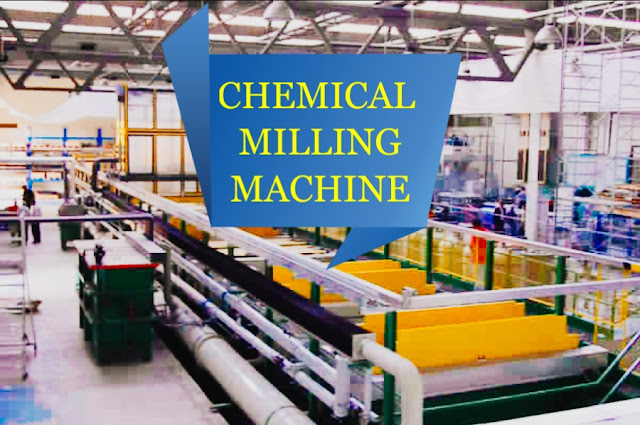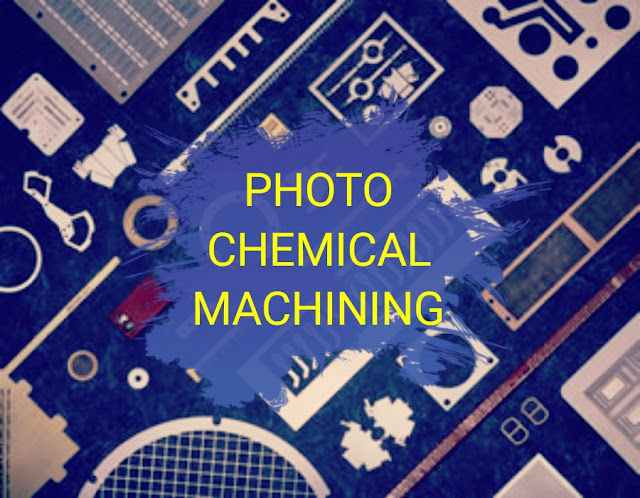CHEMICAL MACHINING
In this process, two most important factors are etchant resistance material (called maskant or resist ) and etchant used.
Types of maskants or resists :- (i) cut and peel maskants, (ii) Photographic resists, (iii) Screen resists.
Factors affecting selection of etchant:
(i) Materials to etched.
(i) Type of maskant or resist used.
(iii) Depth af etch.
(iv) Surface finish required.
(v) Polential damage or alteration of metallurgical propertices of the material
(vi) Speed of material removal
(vii) Permiasible operating environment
(viii) Economics of material removal
(ix) Heat treat condition of material.
CHEMICAL MILLING
Chemical milling is the process used to shape melals to an exacting tolerance by the chemical removal of metal or deep etching of parts.
Amount of metal removed or depth of etch is controlled by amount of immersion time in the etching solution. Location of the unetched or unmilled areas of a part is controlled by masking or protecting these areas from the action of etchant sulution.
Applications :
(i) Remove metal from a portion of the entire surface of formed or irregularly shaped parts such as forgings, castings, extrusions, or formed wrought stock.
(ii) Roduce web thicknesses below practical machining, forging, casting, or forming limits.
(iii) Taper sheets and performed shapes.
(iv) Produce stepped webs resulting in consolidation of several details into one integral piece,
Advantages :
(i) Surfaces with complex profiles of thin sheets can be prepared. No burra are produced.
(ii) Both sides of work sheet can be prepared at a time.
(iii) No mechanical work is done on the surface which offers higher fatigue.
(iv) Process reduces tooling time considerably.
(v) Touling cost is low.
(vi) Process is flexible.
Disadvantages :
(i) Lurger floor area is required because of the size and number of baths required in the process.
(ii) Cost of manufacturing is high.
(iii) Lower metal removal rate is available (0.2 mm per min).
(v) Sharp cuts are not possible.
PHOTOCHEMICAL MACHINING
Photochemical machining or chemical blanking is the process of producing metallie and non-metallic parts by chemicals action. The process consists of placing a chemically resistant image of the part on a sheet of metal and exposing the sheet to chomiçal action which dissolves all the metal except the desired part. Most parts produced in this way are similar to thin gauge stampings and are generally flat and of complex design.
In photographie resist process of photochemical machining metal ean be chemically cleaned in numerous ways including decreasing, pumice scrubbing, electro cleaning, or chemical cleaning, Cleaned metal is Coated with photographic material which exposed to light of the proper wavelength, will polymerize and remain on the panel as it goes through developing stage. This polymerized layer then acts as the barrier to the etching solution applied to the melal Methods of coating the metal with the photo-resist are dipping, spraying. flow coating, dollar coating, or laminating. Most applicable method is determined by the type of resist used and the part's physical form.
Applications :
The use of photochemical machining is generally limited to relatively thin materials, from 0.002 mm to 1 mm thick. The limit of material thickness is generally a function of the tolerance desired on finished parts.
Advantages :
(i) Working on extremely thin materials where handling difficulties and die accuracies proclude the use of normal mechanieal methods.
(ii) Working on hardened or brittle materials where mechanical action would cause breakage or stress concentration points. Chemieal blanking works well on spring materials and hardened materials which are relatively difficult to punch.
(iii) Production of parts which must be absolutely burr-free.
(iv) Production of extremely complex parts where die cost would be prohibitive.
(v) Producting short run parts where relatively low setup costs and short cut from print to production offer advantages. This especially important in research and development projects and in model shops.
LASER BEAM MACHINING (LBM)
The word LASER stand for "Light Amplication using Simulated Emission of Radiation." Laser provides intense and uni-directional beams of light; this light is coherent in nature. The mechanism by which a laser beam removes material from the surface boing worked involves a combination of the melting and evaporation processes. However, with some materials, the mechanism is purely one of evaporation.
Advantages :
(i) No mechanical contact botween tool and the work.
(ii) Beam can be proejcted through a transparent window.
(iií) Laser can be used with materials sensitive to heat shock such as ceramics.
(iv) Workpiece is not subjected to large mechanieal forces.
(v) Laser operates in any transparent environment including air, inert gas, vacuum and even certain liquids.
Disandvantages :
The laser system is quite inefficient.
#fizaengineering.......Sk Najmul ( munna )
****Follow me****
:- https://m.facebook.com/fizaengineer/
:- https://m.dailymotion.com/fizaengineer/
:- https://webtalk.com/sknajmulhaque/





0 comments:
Post a Comment
Please do not enter any spam link in the comment box.